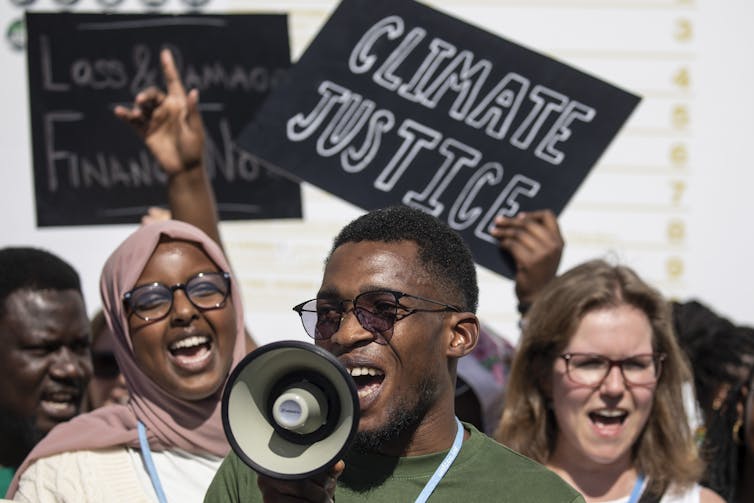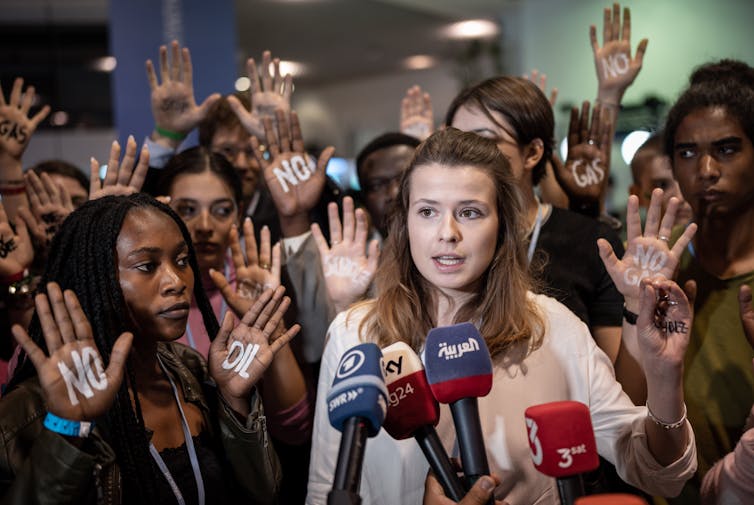Throwing soup on a Van Gogh and other ways climate protesters are making their voices heard over Egy
Activists aren’t necessarily more aggressive than in the past, but they are using creative and sometime shocking new tactics that quickly go viral.

In London, youth activists threw soup at Van Gogh’s “Sunflowers,” asking, “Is art worth more than life? More than food? More than justice?” In Melbourne, Australia, two protesters superglued themselves to Picasso’s “Massacre in Korea” to highlight the connections between climate change and future conflict and suffering. Others have engaged in similar protests, targeting a Boticelli at the Uffizi Gallery in Florence, Italy, an ancient Roman statue at the Vatican and a mummy exhibit at Barcelona’s Egyptian Museum.
Their actions have incited mixed responses around the world. Some people praised the activists’ daring and ingenuity; others lambasted the groups for polarizing the fight for climate justice, sending mixed messages and using plain poor logic.
But tactics like these draw media attention and make a lasting impression, and that’s the point – especially right now.
Normally in November about this time, tens of thousands of climate activists converge on the United Nations climate summit, with noisy street theater and large marches that can be counted on to draw media attention and light up social media feeds.
This year’s summit is in Egypt, where the government effectively bans public protests and has cracked down on political dissent. Small pop-up rallies have appeared briefly in U.N.-controlled areas. And the U.N. allowed a march of several hundred people on Nov. 12, 2022, but it had to be inside the conference venue. The Egyptian government agreed to arrange a designed protest space – but it’s several blocks away from where negotiators and heads of state are meeting, and is monitored by Egyptian security.

Instead, activists have been working from the inside, and using audacious actions in their home countries, to draw public attention to the cause.
I study the role of disruptive politics and social movements in climate policy and am in touch with activist groups at the summit. With governments slow to act on the rising climate risk, young activists in particular are growing in number and organizing globally over social media. They aren’t necessarily more aggressive than in the past, but they are finding creative ways to make their voices heard.
A brief history of protest and division
Environmental activist groups have always had differences of opinion on policies, different visions of the future and different approaches, from family-friendly actions to more radical and destructive acts.
In the first part of the 20th century, the division was between preservationists, who wished to keep ecosystems pristine, wild and untarnished by humans, and conservationists, such as President Theodore Roosevelt, who believed natural resources should be extracted for human use but at a rate that would preserve them for future generations.
In the 1970s and 1980s, following the success of the first Earth Day and the signing of the landmark U.S. Clean Air and Clean Water acts, many environmental nonprofits professionalized. They invested time in lobbying, set up offices in Washington and began courting corporate partnerships.
Other environmentalists accused them of selling out and called them “light greens,” or “shallow environmentalists.”
From that mindset emerged “deep” or “radical” environmentalism, which argued that the only way to save the world from irreversible damage was to challenge political and economic systems rather than work from inside them. Groups like Earth First! embraced radical tactics, such as sabotaging oil pipelines and blocking logging forests. Earth Liberation Front went further, claiming several acts of arson in the 1990s.
Tamer but more global protests today
Recent years have seen an uptick again in confrontational actions that draw attention, like shutting off oil pipelines, staging standoffs to block oil infrastructure and throwing soup on multimillion-dollar paintings.
But the movement is known better now for peaceful mass protests that draw hundreds of thousands of people with witty signs, theatrics and chanting.
What is unique today is the transnational character of environmental activism, and how young activists have become the face of the climate movement.
Rather than “thinking globally, acting locally,” environmentalists have taken their fight worldwide, often coalescing around key events like U.N. climate summits. With the help of social media, their messaging quickly goes viral. Swedish teenager Greta Thunberg launched the global school strikes for climate, and within months had encouraged over a million schoolkids to walk out of class to demand action on climate change.
Still, for every noisy protest, thousands of climate activists are busy quietly working behind the scenes, lobbying lawmakers, pressuring governments and industries with lawsuits and influencing international negotiations, especially during the U.N. conferences.
Activism behind the scenes at COP27
While the U.N. climate conference in Egypt has meant fewer opportunities to demonstrate, activists are still making their voices heard.
For example, members of the Climate Action Network, one of the largest global climate advocacy networks, get their messages to delegates inside the talks by writing white papers on technical aspects of the talks, offering sample text for consideration and publishing a daily newsletter geared toward negotiators called “The ECO.” The group, credited by scholars for influencing the 1997 Kyoto Protocol, is pushing for action this year on “loss and damage” – compensation for developing countries hit hard by climate change.
At the same time, the Climate Action Network has a long tradition of theatrically awarding a “Fossil of the Day” – a satirical award for those doing the most to block climate progress. And it usually gets media attention.

From the inside and the outside, activists have been a major force in recent years in getting the world to adopt a 1.5 degree Celsius target for limiting global warming and introducing language on “climate justice” and human rights in the 2015 Paris Agreement.
For groups of activists often fighting oppressive, hierarchical structures, the horizontal form of organizing, with fluidity and lack of structure, is the very ethos they are trying to emulate and support.
So, looking at the young protesters throwing soup on a Van Gogh, given the lack of progress in nearly 30 years of global climate negotiations, broken promises on climate finance and the disinformation in some media coverage of climate change, more provocation may be exactly what is needed to draw attention to the problem. And so is the tough work you don’t see that’s influencing the negotiations.
Shannon Gibson is affiliated with the Global Justice Ecology Project.
Read These Next
Deepfakes leveled up in 2025 – here’s what’s coming next
After a year of fast advances, deepfakes are entering a new era defined by real-time interaction with…
Resolve to network at your employer’s next ‘offsite’ – research shows these retreats actually help f
Because they can help you get to know more of your co-workers, offsites may build the kind of trust…
West Antarctica’s history of rapid melting foretells sudden shifts in continent’s ‘catastrophic’ geo
A picture of what West Antarctica looked like when its ice sheet melted in the past can offer insight…






